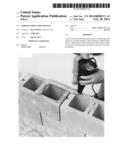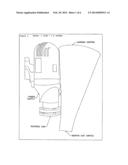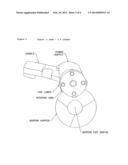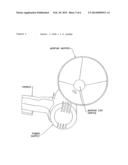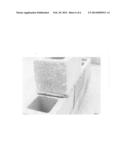Patent application title: Mortar Application Device
Inventors:
Steven Wilcox (Erial, NJ, US)
IPC8 Class: AE04G2120FI
USPC Class:
401137
Class name: Coating implements with material supply including means for dispensing material directly to work surface
Publication date: 2014-02-20
Patent application number: 20140050513
Abstract:
A device used for the placement mortar or similar type substances in a
specific location. Those locations could be brick, block or other places
where mortar and other similar materials are used in construction and
repair of masonry structures and objects.Claims:
1. The "Mortar Application Device" is a tool used for controlling the
placement of "Mortar" using a combination of gravity and vibration.
2. The "Mortar Application Device" has a mortar hopper that holds the material until it is needed. This is accomplished by using a conical shaped hopper with a narrow exit orifice. The viscosity of the mortar combined with the narrow exit orifice keep the mortar in place until it is needed.
3. The "Mortar Application Device" is able to achieve the placement of the material/mortar without contact with any moving parts.
4. The "Mortar Application Device" is able to place the mortar (or other similar type materials) in a very even and consistent manner.
5. The "Mortar Application Device" is able to place the mortar (or other similar type materials) in a much more rapid fashion than tools currently in use.
6. The "Mortar Application Device" creates cost of construction savings due to the reduction of waste. This is accomplished because mortar is placed where it is needed and only where it is needed.
Description:
FIELD OF THE INVENTION
[0001] The present invention relates to a method for controlling the placement of mortar or other similar materials.
BACKGROUND
[0002] Present day tools typically used for the placement of mortar include a trowel for placing the mortar and a hawk for holding the mortar. The "Mortar Application Device" replaces these two tools to allow for rapid and even application of mortar where it is desired.
[0003] The "Mortar Application Device" is an invention I created in order to construct block and masonry walls more effectively. The prototype shown in the attached photos was constructed by me to meet that need. I actually tried to locate and purchase a similar device but was unable to find anything suitable
SUMMARY OF THE INVENTION
[0004] The object of this invention is to create a way to place mortar in an even, consistent and rapid manner. The speed with which this device works is critical as properly mixed mortar has a very short shelf life, typically 90 minutes but this time can be shortened dramatically in the event of high temperatures and hot sunlight.
BRIEF DESCRIPTION OF THE PHOTOGRAPHS
[0005] Having thus described the invention in general terms, reference will now be made to the accompanying black and white photographs. I have chosen to use photographs to illustrate this invention as I do not feel simple drawings would properly show the simplicity of this device.
[0006] FIG. 1 is a side view of the "Mortar Application Device". This gives a clear view of the tool. Mortar is placed in the mortar hopper. The mortar hopper will hold the material due to the narrow opening at the bottom labeled "Mortar Exit Orifice". As the cam rotates while in contact with the mortar hopper, it will cause a mild vibrating effect. This mild vibrating effect will cause the static mortar to flow from the mortar exit orifice. This allows the mortar or other similar type material's to be placed in the desired location.
[0007] FIG. 2 is a bottom view of the invention. This shows how the cam wheel interacts with the mortar hopper.
[0008] FIG. 3 is a top view of the invention. This shows the mortar hopper, power source and handle.
[0009] FIG. 4 is photo showing the "Mortar Application Device" in action. Please note how the mortar exits the tool and creates an even consistent bead of material. By only placing mortar where desired it will result a decrease in material needed to do any masonry job.
[0010] FIG. 5 is another photo showing the "Mortar Application Device" in action. Again please note how even and consistent placement of mortar is.
[0011] FIG. 6 is a photo showing the result of doing block with the "Mortar Application Device". Please note how even the bead is protruding from between the block. By having just a slight excess of mortar it makes pointing of the block much easier.
DESCRIPTION OF THE INVENTION
[0012] The "Mortar Application Device" is constructed using a power source combined with a mortar hopper. The power source rotates a cam wheel. This cam wheel makes contact with the mortar hopper. The resulting vibration from the cam wheel to the mortar hopper causes the mortar to flow from the mortar exit orifice.
[0013] The power source in my current prototype uses electricity but can easily be converted to operate on battery power.
[0014] Mortar itself is a very dirty and gritty material. It is mainly composed of sand and Portland cement. Both materials are highly destructive to any power tool. By keeping a clear separation between the power source and the mortar, the tool could last for years.
DESCRIPTION OF PICTURES
[0015] FIG. 1 is a side view of the "Mortar Application Device". This view clearly shows how the exit orifice.
[0016] FIG. 2 is the bottom view. This shows how the cam wheel makes contact with the lower side of the mortar hopper. When the cam wheel rotates it imparts a vibrating effect causing the mortar to flow from the mortar exit orifice in a smooth and consistent manner.
[0017] FIG. 3. This is the top view showing the power source, handle, mortar hopper and mortar exit orifice. The mortar is placed into the hopper for distribution to any selected surface.
[0018] FIG. 4: This picture shows Mortar Application Device in action. Note how the tool places a mortar bead that is even and consistent
[0019] FIG. 5: Another picture showing a near perfect bead of mortar.
[0020] FIG. 6: This picture shows the resulting mortar bead during the construction process.
User Contributions:
Comment about this patent or add new information about this topic:
| People who visited this patent also read: | |
| Patent application number | Title |
|---|---|
| 20170148505 | SEMICONDUCTOR DEVICE |
| 20170148504 | CONTROLLING A REFRESH MODE OF A DYNAMIC RANDOM ACCESS MEMORY (DRAM) DIE |
| 20170148503 | DYNAMIC RANDOM ACCESS MEMORY CIRCUIT AND VOLTAGE CONTROLLING METHOD THEREOF |
| 20170148502 | MEMORY MANAGEMENT DEVICE, INFORMATION PROCESSING SYSTEM, AND METHOD OF CONTROLLING MEMORY MANAGEMENT DEVICE |
| 20170148501 | SEMICONDUCTOR MEMORY DEVICE AND MEMORY SYSTEM INCLUDING THE SAME |

